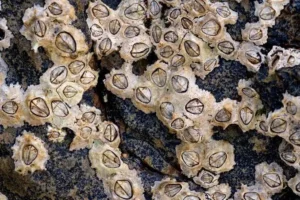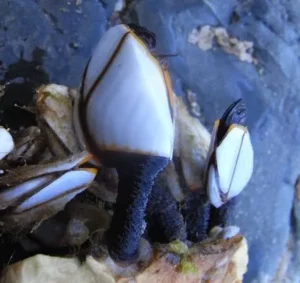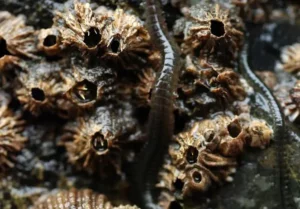A barnacle is a species of arthropod that belongs to the subclass Cirripedia, making it a relative of crabs and lobsters. Let us discuss a few of the most common barnacles below.
- Semibalanus balanoides
- Balanus glandula
- Austrominius modestus
- Amphibalanus improvisus
- Amphibalanus amphitrite
- Chthamalus stellatus
- Megabalanus coccopoma
- Lepas anatifera
- Ivory barnacle
- Balanus nubilus
- Semibalanus cariosus
- Megabalanus tintinnabulum
- Pollicipes pollicipes
- Pollicipes polymerus
- Paraconcavus pacificus
- Chthamalus antennatus
- Balanus trigonus
Semibalanus balanoides
Semibalanus balanoides, often known as the common barnacle, common rock barnacle, or northern rock barnacle, is a widely distributed acorn barnacle species native to the boreo-arctic region. In the intertidal zone of north-western Europe and both coastlines of North America, it is typical on rocks and other substrates.
Balanus glandula
One of the most prevalent barnacle species on the Pacific coast of North America is the Balanus glandula, which is found from Alaska in the United States to Bahia de San Quintin, which is close to San Quintin, Baja California. They are frequently observed on mussels, rocks, and pier pilings in the upper intertidal zone. Both water and air can provide them with oxygen.
Austrominius modestus
A species of barnacle belonging to the Elminiidae family by the name of Austrominius modestus is endemic to Australia, Tasmania, and New Zealand but has since expanded to Britain and the north-western coastlines of Europe. It can grow to a maximum diameter of about 10 millimetres (38 mm).
Amphibalanus improvisus
The bay barnacle, also known as the European acorn barnacle or Amphibalanus improvisus, is a type of acorn barnacle that belongs to the Balanidae family.The smooth, white or light grey, conical calcareous shell of Amphibalanus improvisus is made up of six fused plates. At the top, there is an oval or rhombic hole that is closed off by two hinged plates.
Amphibalanus amphitrite
The family Balanidae includes the acorn barnacle species Amphibalanus amphitrite. It goes by the names Amphitrite’s rock barnacle, purple acorn barnacle, and striped barnacle in warm and temperate waters all over the planet.
Chthamalus stellatus
Acorn barnacle species, Chthamalus stellatus, sometimes known as Poli’s stellate barnacle, is widespread on rocky coasts in South West England, Ireland, and Southern Europe. It is a sessile barnacle that uses its membrane base to cling to rocks and other solid objects in the intertidal zone. Although it is essentially cone-shaped, in a busy colony it can take on a more tubular appearance.

Megabalanus coccopoma
Megabalanus coccopoma, sometimes known as the titan acorn barnacle, is a tropical species of barnacle that Charles Darwin originally identified in 1854. With calcareous plates forming a steep-sided cone that reaches a height and width of 5 centimetres, the titan acorn barnacle is a huge species (2.0 in).
Lepas anatifera
Lepas anatifera, often called the smooth gooseneck barnacle or the pelagic gooseneck barnacle, is a species of barnacle belonging to the Lepadidae family. These barnacles are frequently found in huge numbers connected to floating wood, ship hulls, piers, pilings, seaweed, and assorted flotsam and jetsam via their flexible stalks.

Ivory barnacle
The ivory barnacle is a species of acorn barnacle that belongs to the Balanidae family. It is a medium-sized sessile barnacle with a cone-shaped body and a white test made of fused plates. It has a hinged lid made of two triangular halves that are each made up of two plates, a tergum, and a scutum, protecting a diamond-shaped operculum.
Balanus nubilus
The largest barnacle in the world, Balanus nubilus, also known as the giant acorn barnacle, has the largest known muscle fibres and can grow up to 30 cm tall with a diameter of 15 cm.
Semibalanus cariosus
Acorn barnacle species Semibalanus cariosus, often referred to as the thatched barnacle, rock barnacle, or horse barnacle, is found in the northern Pacific Ocean. The six wall plates of this barnacle are fashioned with vertical tubes-like ribs that project downward onto the rock like the edge of a thatched roof.

Megabalanus tintinnabulum
A species of big barnacle in the family Balanidae is called Megabalanus tintinnabulum. It is the genus’ type species. The particular name, which translates from the Latin tintinnabulum to “handbell,” possibly alludes to the way the barnacle clusters resemble a collection of tiny bells.
Pollicipes pollicipes
A species of goose barnacle is Pollicipes pollicipes, also referred to as the goose neck barnacle, goose barnacle, goose, or leaf barnacle. It develops in clusters on rocks, shipwreck hulls, driftwood, and other surfaces.
Pollicipes polymerus
A species of stalked barnacle called Pollicipes polymerus is also referred to as the gooseneck barnacle or the leaf barnacle. It can be found on the rocky shores of North American Pacific coasts, frequently in large numbers.
Paraconcavus pacificus
A species of balanid barnacle known as Paraconcavus pacificus, or the red-striped acorn barnacle, is found in subtidal sandy areas throughout the outer northeastern Pacific coast, from Baja California north to Monterey Bay. It expands to a diameter of 35 mm.
Chthamalus antennatus
The six-plated barnacle, Chthamalus antennatus, is a type of intertidal barnacle that can be found in eastern and southern Australia. Initially one centimetre high and two centimetres wide. The barnacle is typically found on rocks along the coast, either just below the splash zone or at high tide level or above. Feeding only happens during unusually high tides.
Balanus trigonus
A type of barnacle belonging to the Balanidae family is called Balanus trigonus. It is a conical barnacle with steep sides, six shell plates, and a pink colour. They are endemic to the Indo-Pacific region and opportunistic fouling organisms.
Conclusion
To summarise this article, we can say that barnacles are filter-eating organisms that are crucial to the food chain. In order to make seawater suitable for other creatures, barnacles, which are suspension feeders, consume plankton and dissolved debris suspended in the water. They supply these creatures with food as well.
Also Read:
- Silverfish characteristics
- Endocytosis molecular movement
- Crab characteristics
- Dna replication vs polymerase
- Zygote vs embryo
- Creeper plant example
- Glass sponges types
- Stop codon example
- Hand anatomy
- What is the function of ribosomes

Hi…I am Sadiqua Noor, done Postgraduation in Biotechnology, my area of interest is molecular biology and genetics, apart from these I have a keen interest in scientific article writing in simpler words so that the people from non-science backgrounds can also understand the beauty and gifts of science. I have 5 years of experience as a tutor.
Let’s connect through LinkedIn-